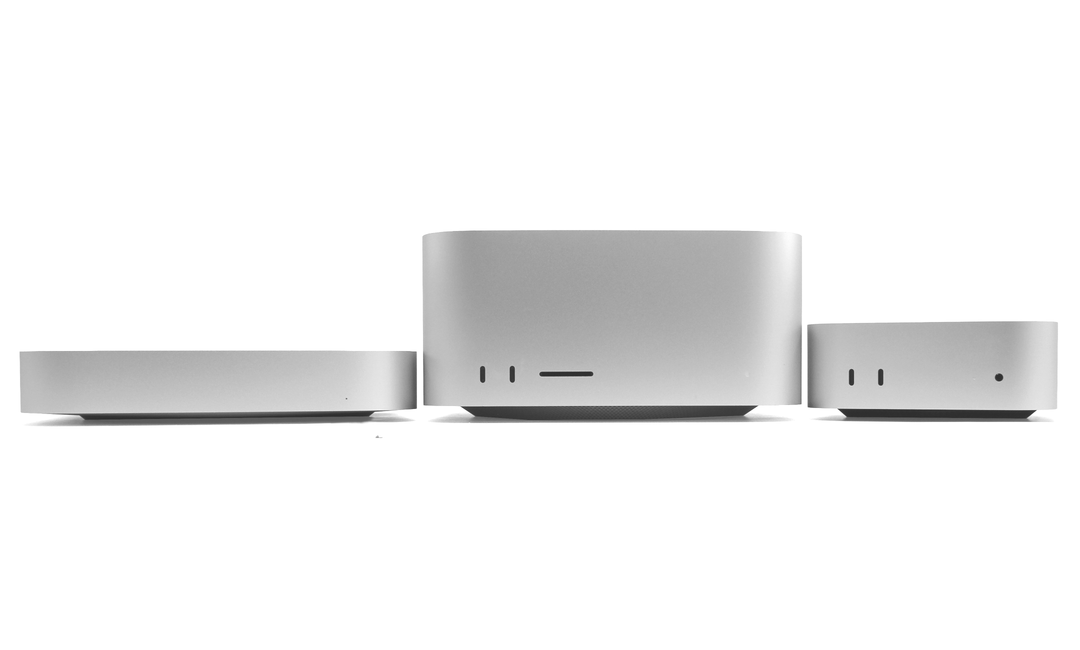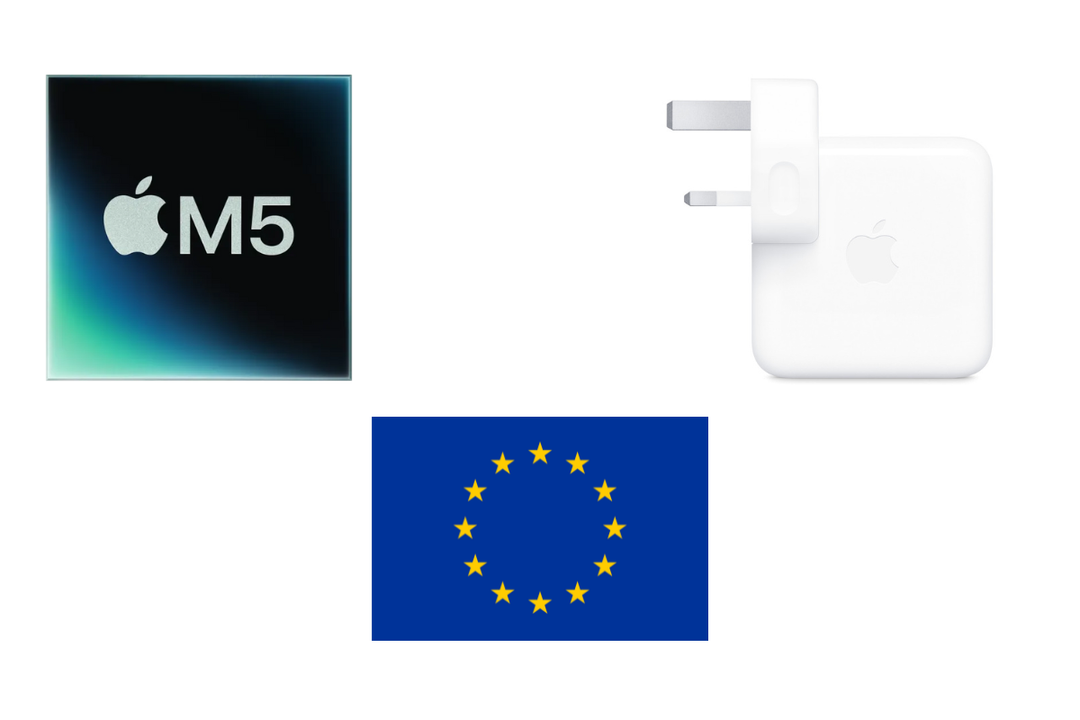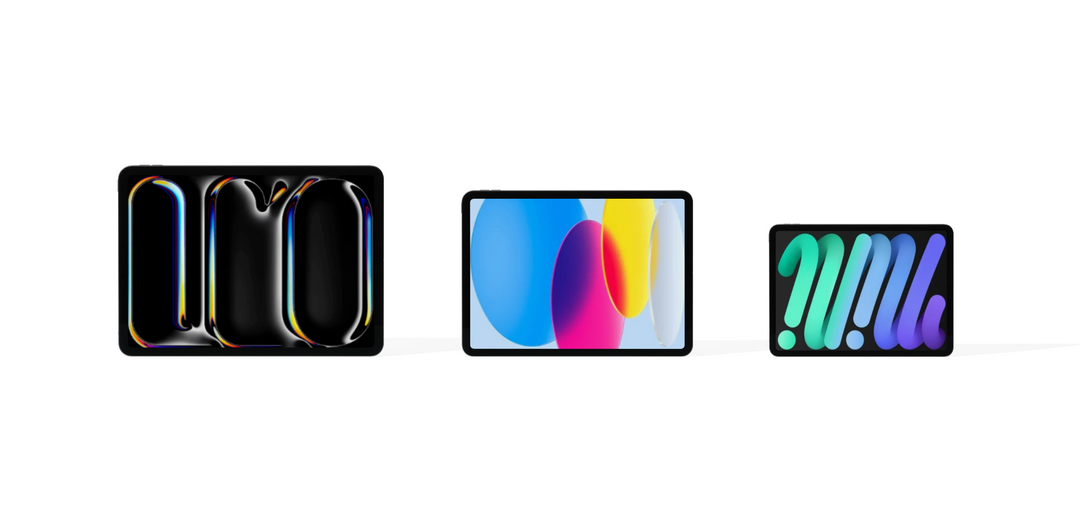A month has passed since Apple released the newly re-designed Mac mini M4, further adding to its lineup of desktop computers. With so many options available, it can be difficult to know what device will match your use and budget.
In this article, we are going to compare the different models of Apple silicon Mac mini and Mac Studio looking closely at the performance, design and connectivity.
Specifcation comparison
There is a significant difference between the different models of Mac mini and Mac Studio, with the option to go for a variety of CPU, GPU, memory and storage configurations. The reason for the variances are due to the ways in which the devices are meant to be used.
| Model | CPU | GPU | NPU | Memory | Storage |
| 8-core | 8-core | 16-core | 8GB or 16GB | 256GB, 512GB, 1TB | |
| 10-core | 24-core or 32-core | 16-core | 32GB or 64GB | 512GB, 1TB, 2TB, 4TB | |
| 20-core | 48-core or 64-core | 32-core | 64GB or 128GB | 1TB, 2TB, 4TB or 8TB | |
| 8-core | 10-core | 16-core | 8GB, 16GB or 24GB | 256GB, 512GB, 1TB | |
| 10-core or 12-core | 16-core or 19-core | 16-core | 16GB or 32GB | 512GB, 1TB, 2TB, | |
| 12-core | 30-core or 38-core | 16-core | 32GB, 64GB or 96GB | 512GB, 1TB, 2TB, 4TB | |
| 24-core | 60-core or 76-core | 32-core | 64GB, 128GB or 192GB | 1TB, 2TB, 4TB or 8TB | |
| 10-core | 10-core | 16-core | 16GB, 24GB or 32GB | 256GB, 512GB, 1TB | |
| Mac mini M4 Pro | 12-core | 16-core | 16-core | 24GB, 48GB or 64GB | 512GB, 1TB, 2TB, 4TB |
Ports and connectivity
Mac mini M1 and M2
The Mac mini M1 and M2 share the same number of ports, with two USB-A (Up to 5 Gb/s) and two Thunderbolt ports to the rear of the device. The Thunderbolt ports on the M1 are Thunderbolt 3 (up to 40 Gb/s) and the M2’s ports are Thunderbolt 4 (up to 40 Gb/s). Both devices also come with a HDMI port, Gigabit Ethernet and headphone jack.
Mac mini M2 Pro
The Mac mini M2 Pro has two extra Thunderbolt 4 ports.
Mac studio M1 Max and M2 Max
The Mac Studio models (M1 Max/M2 Max) have two USB-C ports (up to 10gb/s) at the front of the device, and an SD card slot. To the rear of the device are two USB-A (Up to 5 Gb/s) ports and four Thunderbolt 4 (up to 40Gb/s). Both devices also come with a HDMI port, 10 Gigabit Ethernet and headphone jack.
Mac studio M1 Ultra and M2 Ultra
The Mac Studio models (M1 Ultra/M2 Ultra) have two Thunderbolt 4 (up to 40Gb/s) at the front of the device, and an SD card slot. To the rear of the device are two USB-A (Up to 5 Gb/s) ports and four Thunderbolt 4 (up to 40Gb/s). Both devices also come with a HDMI port, 10 Gigabit Ethernet and headphone jack.
Mac mini M4 and M4 Pro
As for the latest iteration of Mac mini M4, Apple decided to remove the USB-A ports entirely, instead opting for two USB-C ports to the front of the device and three Thunderbolt ports to the rear of the device. The Thunderbolt to the rear of the M4 are Thunderbolt 4 (up to 40 Gb/s) and the M4 Pro version are Thunderbolt 5 (up to 120 Gb/s). Like the previously mentioned devices, you will also get a HDMI port, and Gigabit Ethernet (configurable to 10 Gigabit). With the new design, the headphone jack has also moved to the front of the device.
Another significant change to the location of buttons and ports on the Mac mini M4 and M4 Pro is the location of the power button. All the previous Mac mini and Studio models had a rear facing power button, whereas the new Mac mini M4 and M4 Pro have the power button located at the foot of the device.
Display Connectivity
Mac mini M1
The Mac mini M1 supports up to two displays. One display up to 6K resolution at 60Hz connected by Thunderbolt and or one display with 4k resolution at 60Hz connected with HDMI.
Mac mini M2
The Mac mini M2, also supports up to two displays. One display up to 6K resolution at 60Hz connected by Thunderbolt, and one display up to 5K resolution at 60Hz over thunderbolt or a 4k resolution display at 60Hz connected by HDMI
Mac mini M2 Pro
For the Mac mini M2 Pro you get support for up to three displays simultaneously. Two display up to 6K resolution at 60Hz using Thunderbolt, and one display with up to 4K resolution at 60Hz over Thunderbolt or 4K resolution at 144Hz using HDMI.
Alternatively, you can use one display up to 8K resolution at 60Hz or 4K resolution at 240Hz using HDMI
Mac mini M4
Display support was further increased in the M4 version of the Mac mini. Now supporting up to three displays. Two displays with up to 6K resolution at 60Hz using Thunderbolt, and one display at 5K resolution at 60Hz using Thunderbolt, or 4K resolution at 60Hz using HDMI.
Mac mini M4 Pro
As for the M4 Pro, you are able to use up to three displays, with all three up to 6K resolution at 60Hz using Thunderbolt or HDMI.
Further configurations allow up to two displays, one display up to 6K resolution at 60Hz using Thunderbolt and one display at 8K at 60Hz or 4K resolution at 240Hz using Thunderbolt or HDMI.
| Mac mini Model | Maximum Displays |
| Up to two displays | |
| Up to two displays | |
| Up to three displays | |
| Up to three displays | |
| Mac mini M4 Pro | Up to three displays |
Mac Studio m1 Max / M1 Ultra
Both the Mac Studio M1 Max and M1 Ultra have the same level of screen support. They have the ability to support up to four Pro Display XDRs with 6K resolution and over a billion colours, using USB-C, and one 4K display at 60Hz and over a billion colours using HDMI.
Mac Studio m2 Max
The Mac Studio M2 Max can simultaneously support up to five displays. Four with 6K resolution at 60Hz over Thunderbolt and one at 4K with 60Hz using HDMI.
Alternatively, if you want an 8K display, you can opt to use two displays with 6K resolution at 60Hz using Thunderbolt, and one display at 8K with 60Hz or 4K resolution up to 240Hz using HDMI.
Mac Studio m2 Ultra
The Mac Studio M2 Ultra extends its display support to an impressive eight displays. To use eight they will need to be up to 4K resolution at 60Hz.
If you want higher resolution displays, you can opt for six displays up to 6K resolution at 60Hz or three displays at 8K resolution at 60Hz.
| Mac Studio Model | Maximum Displays |
| Up to four displays | |
| Up to four displays | |
| Up to five displays | |
| Up to eight displays |
Form Factor
What makes the Mac mini and Mac Studio so appealing, is the ability to have a powerful desktop computer with a small footprint. They are perfect to keep tucked away on your desk, or as part of your home entertainment system, without the need for a large towering body that traditional desktop computers use.
The Mac mini M1 and M2 models have the same form factor and design, with a length and width of 19.70cm, and a height of 3.58cm.
Mac mini M1 and M2 dimensions
The Mac Studio M1 (Max/Ultra) and M2 (Max/Ultra) are significantly larger than the Mac mini that were previously mentioned, but still fit into the bracket of a compact desktop computer. They have a length and width of 19.7cm and a height of 9.5cm
Mac Studio M1 and M2 dimensions
Apple took the idea of the compact desktop and shrunk it down even further with the Mac mini M4, with a length and width of 12.7cm, and a height of 5cm.
Mac mini M4 dimensions
Performance Benchmarks
Benchmarking is a great way to compare the efficiency of a device. A benchmark software will run a set of programs to assess the performance of a device and provide a score based on how proficient it is in completing the workload. The scores are based on real world scenarios that a device is likely to experience while being used.
Geekbench 6 is a popular benchmarking software that we used to compare both the Mac mini models and the Mac Studio. With this software you are able to get a proficiency score for the CPU, GPU and NPU.
CPU Multi-core Performance
We used Geekbench 6 to compare the CPU Multi-core scores across the entire lineup of Mac mini and Mac Studio. The scores that you can see in the graph are an accumulation of multiple benchmarks from the users on the Geekbench database.
GPU Benchmark scores
To get a good indication of the graphical capabilities of each device, we have gathered the Geekbench Metal score for each device that indicates how efficient the GPU is at managing workloads.
NPU Benchmark scores
AI capability and readiness are rapidly becoming the focal point of modern technology. All Apple silicon devices contain an NPU (Neural Processing Unit) that were created to simulate the functionality of the human brain, and are optimised for machine learning and AI.
We used Geekbench AI to measure the efficiency of the Mac mini and Mac Studio models for AI related workloads.
Final Thoughts
The M1, M2 and M4 Mac mini are the perfect device for office tasks like word processing, internet browsing, emails and spreadsheets. While also doubling up as a family desktop or home media system. They take up a small footprint on your desk and can be tucked away on your desk.
The Mac mini M2 Pro/ M4 Pro are a perfect middle ground for both office and professional applications. They are powerful enough to handle photo editing, video editing and music production.
If you are looking for an all round powerful device that is capable of handling any task, the Mac Studio is the device to go for. The Mac Studio is tailored towards professionals who need the added CPU and GPU cores for intensive work such as high resolution video editing, photo editing and music production. Configurable with up to 128GB on the M1 Ultra and 192GB on the M2 Ultra, the Mac Studio is the only choice for those requiring large amounts of memory.
Another standout feature of the Mac Studio is its exceptional connectivity. If your setup requires multiple peripherals and displays, the Mac Studio’s versatility is unmatched when compared to the Mac mini.
If you’re considering purchasing a Mac mini or Mac Studio, take a look at our selection. We offer a wide variety of models in stock and ready for dispatch. Click here to explore our products.



